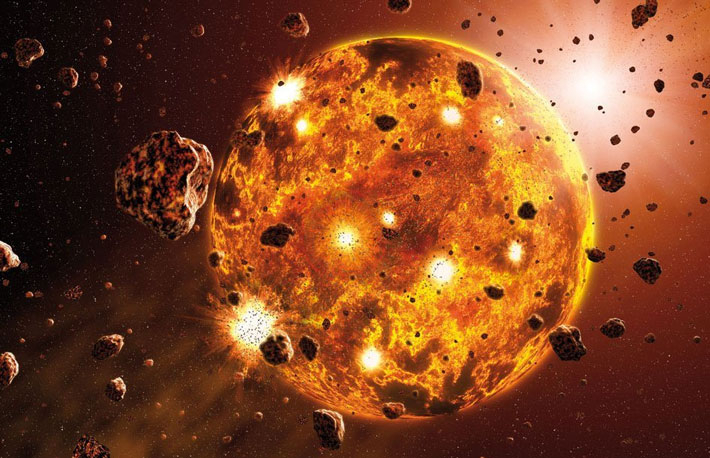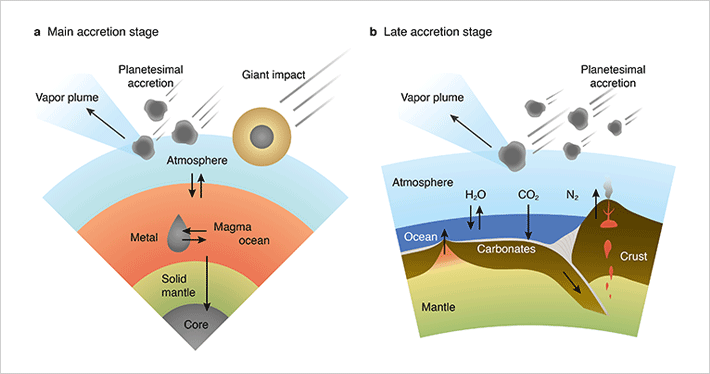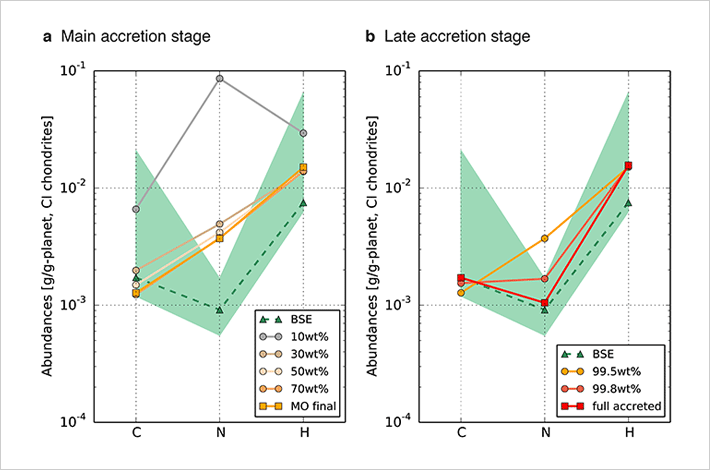Chondritic meteorites are among the first solid materials to form in the early Solar System. It is commonly thought they delivered Earth's volatile elements based on analysis of the isotopes they contain. However, the abundances of C, N and H in what scientists call the "bulk silicate Earth" or "BSE" (which includes the atmosphere, oceans, crust, and mantle) are significantly different from their abundances in chondrites; in addition to their simply being relatively less of these particular elements in the BSE, there is also a notable lack of nitrogen. Due to these discrepancies, the origin of Earth's major volatile elements remains mysterious, and previous studies have proposed non-chondritic, differentiated meteorites or asteroids might have delivered them.
The new study showed that the BSE's C, N, and H depletion pattern could indeed be due to the continual infall of chondritic bodies if their volatiles were affected by the Earth-formation process itself. First, the study proposes that since the planet was essentially a molten ball of rock in its earliest stages, significant amounts of C could have been removed into Earth's core. Later, as the planet cooled and solidified and the oceans formed, C and H would have been deposited as water and carbonate rocks. At the same time, N largely remained in the atmosphere, where subsequent explosive meteorite impacts blasted some of it into space.
The researchers modelled the evolution of the volatiles' abundances in the atmosphere, oceans, crust, mantle, and core from the earliest stages of Earth's formation, taking all of these factors into account, as well as constraints about the Earth's formation, such as its early mineralogy and the size distribution of incoming asteroids and meteorites. They then compared the final volatile inventory under various conditions to the current Earth.
Team member Kurokawa says, "The origins of Earth's habitable environment and how life emerged are undoubtedly exciting questions. The fact that the Earth is habitable is not just because it has liquid water on its surface, though that is important, but also because its atmosphere C and N help keep Earth' surface warm enough to sustain liquid water. The abundance of these major volatile elements matters; if we increased or decreased their abundance by even a factor of a few times, Earth might have been a completely dry planet or completely ocean-covered one, or its climate might have been extremely hot or cold."
Kurokawa further explains that scientists have for some years been interested in a region around stars they call the "habitable zone" or HZ, which is a distance at which a planet receives enough energy from sunlight to keep a planet's surface cold enough to retain water, but warm enough to keep that water liquid. Whether a planet exists in the HZ also depends, however, on the planet's mass and chemical composition, since small, low-mass planets more easily lose volatiles due to gravitational escape, and planetary atmospheres can help warm planets by trapping outgoing infrared radiation through so-called greenhouse-warming.
The study explains the abundance of Earth's major volatile elements and shows that Earth's volatile composition is a natural outcome of forming an Earth-sized planet in an HZ. In contrast, the researchers suggest that Venus (which formed nearer to the Sun than the proposed HZ) and Mars (which is ten times smaller than Earth) should have acquired different volatile abundances.
The authors think these results can further help predict which extrasolar planets in the HZs of their host stars should be truly habitable. Astronomers have already found Earth-sized planets located in HZs around other stars, though their surface environments are so far not observable. This study predicts that provided such planets formed similarly to Earth, they really are Earth-like planets; and may have abundances of major volatile elements similar to Earth, and thus likely evolve as Earth did and therefore also good candidates to search for life beyond Earth.
The authors note there is some uncertainty in some of the parameters they modelled. Each parameter has a different degree of uncertainty. For instance, how elements partition between silicate magma and core-forming metal has an order of magnitude uncertainty typically. Incorporating all of these different processes into a single model in a simple way and quantifying the influence of their uncertainties required running their model many times with different parameters.
Says Kurokawa, "We are interested in how habitable environments which can sustain life can develop on Earth and other planets and, consequently, the question "Is Earth special or common?". Earth's surface environment is controlled not only by its distance from the Sun and the presence of water but also by its inventory of major volatile elements such as C, N and H. This is an important question in particular because Earth's volatile abundance differs so greatly from the primitive Solar System bodies in our Solar System from which Earth is thought to have formed."
Previous attempts to explain the abundance of Earth's volatile elements have focused on limited consideration of the interplay of planet formation processes. This study is the first to model how the abundance of major volatile elements may have changed during Earth's accretion and how we can reproduce the observed composition.
"One of the new questions this work raises is how the distribution of major volatile elements was determined early in Earth's history," Kurokawa adds. "Our model predicts these volatiles were mostly hosted in the surface soon after Earth's formation. In contrast, the largest reservoir of them today is the mantle. Plate tectonics should be responsible for this change. However, when and how these volatiles were transported to the mantle is a yet unsolved question. This is also related to the emergence and evolution of life on Earth; N is sometimes the limiting factor for biological activity, and the present-day N cycle is largely dominated by life."
A future question the team aims to address is whether the same planet formation scenario can explain the volatile abundances of other terrestrial planets, including Venus, Mars, and extrasolar terrestrial planets. Venus' surface, including the atmosphere, will be explored by future missions by NASA (DAVINCI+, VERITUS) and ESA (EnVision). Though little or no data is available for the volatile compositions in those planets' interiors, some information is available from the analysis of Martian meteorites and seismological measurement from the Mars InSight mission. The team believes that testable predictions for these planets can be developed from this study.
. Any information published on this site will be valid in relation to Science Tokyo.






